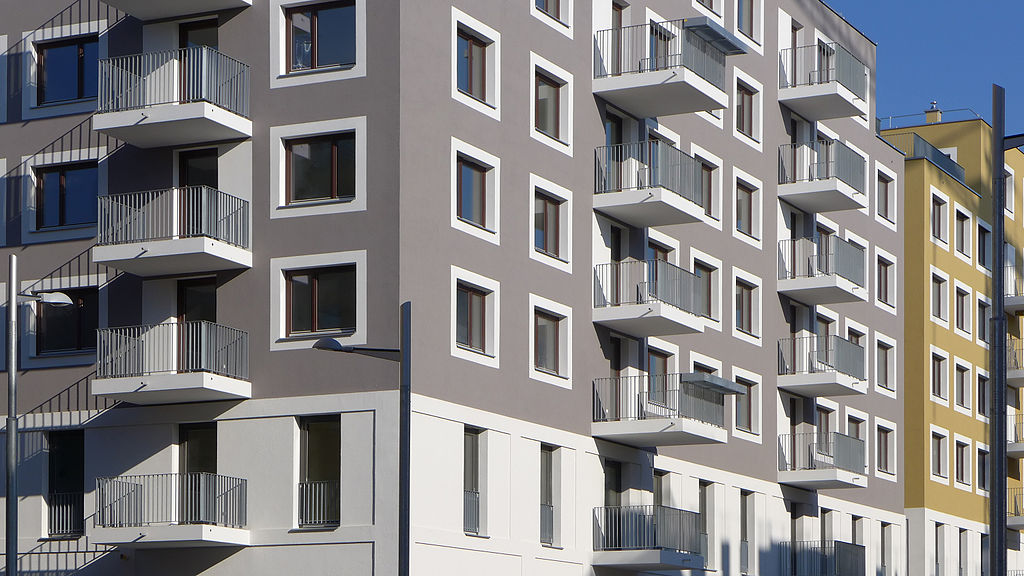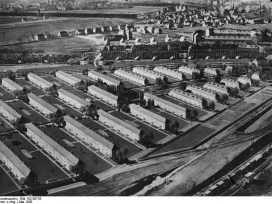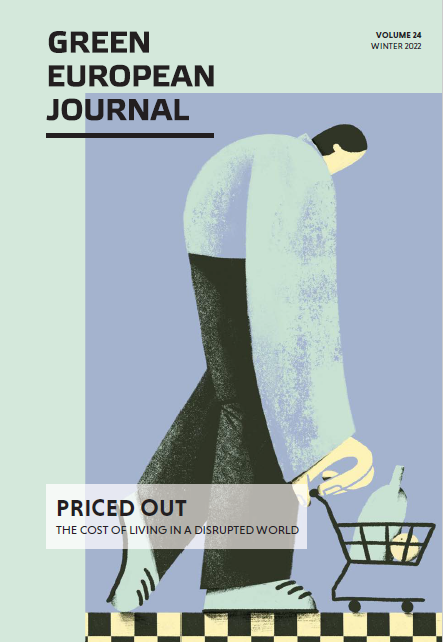Since the 1980s, a wave of privatization has turned housing into a market commodity. Though tourism platforms and corporate landlords are more present than ever, an increasing number of European cities are fighting back, following the path laid out by Vienna.
House prices and rental costs are increasingly out of reach for many residents of European cities. While this problem has been growing for decades, the increased commodification of housing since 2008 has worsened the situation markedly. But if political commitment can be secured for the long haul, green social housing designed and accessible for all can make the right to housing a reality.
It is over 10 years since an unsustainable housing sector triggered the global financial crisis. Yet despite the damage done, housing continues to be treated as a commodity. Hedge funds, tourist platforms, and corporate landlords are more present than ever in European cities. The result is that European rents have increased by 16 per cent and housing prices by 42 per cent since 2010.1
The notion that house prices are determined by the laws of supply and demand is deeply rooted. Nevertheless, it is a misconception. In the long run, governments shape the contours of the housing system in any given jurisdiction. The tax system, urban planning, social housing policy, tenants’ rights and financial regulation are all matters of policy, and together they determine the supply and demand of housing and thus housing conditions for residents.
This explains why housing conditions in cities that are otherwise similar in economic and cultural terms can differ greatly. Vienna is one of the fastest-growing capitals in Europe. Nonetheless, average monthly rents (bills included) in the city were just 8.6 euros per square metre in 2022.2 Conversely, average monthly rents in the cities of neighbouring Germany were about double: 18.90 in Munich, 15.90 in Hamburg and Frankfurt, and 14.30 in Berlin.
The Austrian and German housing landscapes are broadly similar. The level of home ownership is relatively low – 55 per cent in Austria and 51 per cent in Germany – and banks are strict about mortgage lending. In their capitals, homeownership rates are even lower, representing 21 per cent of total housing in Vienna and 17 per cent in Berlin, according to official statistics. In both countries, the authorities tightly regulate the rental market. As a general rule, tenants receive a rental agreement of unlimited duration, and both countries limit the amount by which landlords can raise rents between tenancies.
Despite these similarities, over 10 per cent of German households are overburdened by housing costs, spending more than 40 per cent of their total disposable household income on housing.3 In Austria, it is just 6.1 per cent. These figures do not include mortgage repayments for owner-occupied houses, as Eurostat (highly questionably) considers mortgage repayments as investments.
If calculated using the methodology employed by the German Federal Statistical Office (Destatis), the German housing cost overburden rate was an even-higher 13.9 per cent in 2019, compared to 7 per cent in Austria.4 The pandemic greatly worsened the situation. In 2020, 20 per cent of German households were overburdened – a rate two times higher than the EU average and around three times Austria’s. How can these differences be explained?
Public housing makes the difference
In the years following World War II, western democracies developed vast social and public housing programmes to fulfil the right to housing, and housing became a pillar of the post-war European welfare state.
In the United Kingdom, under the vision of Aneurin Bevan (Minister of Health from 1945 to 1951), council housing was to be built to satisfy the needs of a wide spectrum of society. The British government eventually built 5 million homes between 1946 and 1979. By 1977, public housing made up 32 per cent of England’s housing stock, a proportion that matched the Labour Party’s objective of making sure that council housing was shared among a diversity of social groups.
This chapter ended with the election of Margaret Thatcher in 1979 and the introduction of the Housing Act one year later. The neoliberal era went on to drastically change the housing landscape, with housing gradually becoming a market asset in many countries. In 1980, the newly elected Conservative government introduced Right to Buy, a policy that allowed council tenants to buy their homes at a generous discount. As a result, the public sector sold 2.6 million council houses.
The privatisation of public housing was one of the defining policies of the Thatcher era. More than a simple housing reform, Right to Buy changed the British social fabric, turning many traditionally Labour-voting tenants into Conservative homeowners. In Thatcher’s own words, it paved the way for a ‘property-owning democracy’. House prices are now three times less affordable in the United Kingdom compared to the 1970s.5
From privatization to expropriation in Berlin
In the years after reunification, Germany followed in Thatcher’s footsteps. Up to 1989, housing companies had non-profit status in Germany (including West Germany). But over the 1990s and 2000s, the government privatized most public housing. Municipalities transferred extensive public housing assets to private market-oriented investors, changing the German housing landscape forever.
As a result of privatization, social housing today makes up only about 3 per cent of Germany’s housing stock.6 The origins of its largest corporate landlords were the public housing of the German Democratic Republic (DDR) and the housing assets of West German public corporations. Three million homes that had been owned by the DDR were privatized in the 1990s. Today Europe’s largest private landlord, Bochum-based Vonovia, owns around 400,000 German homes.
Its portfolio was based on the privatised housing assets of Germany’s public railway corporation and the country’s public energy company. These portfolios were bought by US private equity firm Fortress in 2004 through a company that went on to form Vonovia.
In 2004, the state of Berlin sold 60,000 homes to Cerberus Capital Management and Goldman Sachs. These homes were the source of corporate landlord Deutsche Wohnen, which recently merged with Vonovia. This privatization of public stock created social opposition in the long run. In autumn 2021, 59 per cent of Berliners voted in a referendum to expropriate around 240,000 homes from large landlords. The referendum, the official title of which was ‘Expropriate Deutsche Wohnen & Co.’, was unambiguous about its target.

‘Expropriate Deutsche Wohnen & Co.’ march in Berlin. Photo by Shushugah via Wikimedia Commons.
Despite the result, little has happened since. The state government appears reluctant to pursue the expropriations and is not obliged to do so as the referendum was advisory and therefore non-binding. Berlin had also adopted a temporary rent cap that covered 90 per cent of apartments in the city. However, Germany’s constitutional court deemed it unconstitutional. One year on from the referendum, Berliners are still waiting for solutions to soaring rents.
While the way forward remains unclear, the evidence from elsewhere is that though rent controls effectively limit increases, social housing is the key to an affordable, liveable city.
From Red Vienna to Aspern-Seestadt
The neoliberal offensive may have abolished the right to housing in Germany and the United Kingdom. However, the Austrian state of Vienna has never stopped developing sizeable social housing programmes, building on the famous interwar legacy of Red Vienna. This period between 1919 and 1934 saw Vienna develop extensive education, health, and housing programmes driven by the principle of social justice. Under the leadership of the Social Democratic Party of Austria (SPÖ), the city of Vienna built 66,000 public homes between 1919 and 1934. Under the maxim, ‘light, fresh air, and sunshine’, the goal was to provide healthy and beautiful housing for all residents. The SPÖ has won every election in Vienna since the Red Vienna period.
In Vienna, the guiding principle of affordable, high-quality construction is still as pertinent now as it was a century ago. Today, the city council owns 220,000 apartments. Meanwhile, limited-profit housing associations own 185,000 flats and also built a sizeable proportion of the city’s owner-occupied stock through a subsidized housing programme. Sixty-two per cent of Vienna residents live in social housing. By law, only unlimited contracts are allowed on such homes.
Despite the successes of places such as Vienna, vast public housing programmes are still controversial for the European Commission. In 2009, the Commission ruled that the Dutch social housing model was incompatible with EU competition rules. According to this decision, social housing should only target socially disadvantaged persons. Fortunately, Vienna did not follow the Commission’s prescriptions. To prevent the creation of ghettos with rundown public services, the city’s public stock houses people from a wide range of social backgrounds.
Vienna’s social housing sector is thus not ‘discount housing’ destined solely for low-income households. The mission of the Wiener Gemeindebau (Municipal Housing of Vienna) is to provide affordable, high-quality dwellings for broad strata of the population. Income thresholds are designed to ensure that around 80 per cent of all Viennese households are potentially eligible for social housing.
The Austrian capital has managed to adapt its housing policy to ever-changing social conditions. In the 1980s, Vienna was a declining metropolis on the periphery of western Europe. Its development plan focused on urban renewal and the refurbishment of the city’s cultural heritage. The city council renovated around 10,000 housing units a year to improve living conditions while reducing energy and heating costs.
The fall of communism shifted that picture. Vienna became a fast-growing city located at the heart of Europe. It now has 350,000 more inhabitants than in 1989. Throughout the 1990s, social housing, integration, and ecology were the pillars of the city’s policies, making up a comprehensive project focused around quality of life. In a 1995 referendum, Vienna rejected the EXPO megaproject that would have put the needs of tourists over those of residents, choosing instead to develop a renewable hydroelectric project and green spaces around the city.
In 2010, the SPÖ formed a coalition with the Green Party. The Austrian Greens took responsibility for urban planning, energy, and transport. Since then, the city council has raised the rate of affordable housing construction from 3000 to 7000 homes per year to address rising demand, before increasing it further to 10,000 homes per year. Vienna spends over 570 million euros a year on subsidising, building, and maintaining public housing.7
The red-green city council (2010-2019) also prioritised ecological issues. During its term in office, the city began to transform disused freight railway platforms and other brownfield sites into urban residential and commercial areas. Developers were required to build subsidised housing at affordable conditions and the city selected them according to quality-driven tendering. Major housing projects developed by the municipality include Nordbahnhof (10,000 homes), Nordwestbahnhof (10,000 homes), Sonnwendviertel (5,000 homes), and Aspern-Seestadt (11,500 homes).
Human, lively, intimate, and secure
Located in the 22nd district of Vienna, Aspern-Seestadt is Europe’s largest urban development project. By 2030, the city will have invested 5 billion euros to convert 240 hectares of previously disused land into a sustainable residential and commercial area for 25,000 residents, with 20,000 potential workplaces. Swedish urban planner Johannes Tovatt was appointed to design the project. He declared that ‘our ambition has been to provide a master plan that creates streets and public spaces that are fundamentally public, human, lively, intimate and secure.’8
Once construction is complete, 60 per cent of residents will live in subsidised housing of various types, guaranteeing a social mix. The municipality provides the land, while the subsidies go directly to housing associations. The neighbourhood is planned around a five-hectare artificial lake surrounded by a mix of housing, commercial enterprises, and educational institutions. A jury evaluates each housing estate on the basis of architectural quality, cost, social sustainability, and ecological impact. All buildings are either low-energy or passive and are connected to the city-operated district heating system.

Residential area Seestadt Aspern in Vienna 22. Author: Gugerell. Source: Wikimedia Commons.
The area will have a functional mix of living and working spaces to improve mobility. Public transport, bikes, and pedestrians have priority. The target is 40 per cent cycling and walking, 40 per cent public transport, and 20 per cent motorised traffic. As a declaration of intent, the project’s developers made a point of building the underground line first. Their vision is for the nearest public transport option to be closer than the car park wherever you are on the site.
Barcelona against the housing shock
Vienna is not just an isolated case. For Barcelona, it is a model for the housing policy of the future. Over the past five years, social movements and Barcelona city council have little by little moved to take on rising rents and transform the city. This shift represents a breakthrough for the housing system in Spain. While most western European countries were building their welfare states, Spain, Greece, and Portugal were suffering long far-right dictatorships that had no interest in human rights. The transition to democracy in the mid-1970s occurred just as the welfare state began to wane elsewhere. As a result, these countries have low levels of social housing. In Spain, housing is first and foremost a commercial asset.
For the past decade, Spain has been suffering from a ‘housing shock’, a term coined by Irish researcher Rory Hearne to explain the transition between housing systems.9 Easy access to homeownership through over-indebtedness defined Spain’s housing system from the 1960s up to the financial crisis. Since the crisis, high down payments have restricted access to mortgages. At the same time, American hedge funds including Blackstone, Lone Star, and Cerberus burst onto the Spanish housing scene, buying around 500,000 homes through either direct or indirect privatization.10 The result was thousands of evictions and tenants overburdened with high rents.
This did not go unopposed. Grassroots movements such as the Platform Against Evictions and other tenants’ unions arose to fight the unfair housing system. Ever since former housing rights activist Ada Colau became the mayor of Barcelona in 2015, the city council has been following in Vienna’s footsteps. Despite its lack of legislative power and financial constraints, the city council has intervened strongly to increase the stock of affordable housing. Its right-to-housing plan includes public development, public-private-community partnerships, acquisitions, and the temporary mobilization of private housing to be able to reach broad strata of the population. The public housing stock grew from 7,500 units in 2015 to 19,912 in June 2022.
The living tapestry
Similar to Vienna and now Barcelona, France has also resisted the neoliberal housing wave. In 2000, the French government enacted a law on solidarity and urban regeneration, which requires municipalities to meet 25-per-cent targets for public housing by 2025. While this target has not been met by all municipalities, the law has nevertheless resulted in the building of 1.8 million public housing units. The share of the population living in overburdened households – where total housing costs take up more than 40 per cent of disposable income – was 4.7 per cent in 2018 and 5.5 per cent in 2019. This is the lowest in western Europe. Unlike Vienna, however, French public housing projects have often led to segregation and even ghettoization.
Housing systems are the result of political choices. Countries such as Austria and Germany that are quite similar can have vastly different housing outcomes in terms of debt levels, ownership, affordability, and what housing means for the design of our cities. France and Austria have both chosen to pursue the right to housing as a human right through ambitious public and social housing programmes. As the large-scale construction of quality homes takes time, housing systems like those of Vienna and France are long-term political projects. To be successful, policy cooperation at the local, national, and European levels is essential.
With its emphasis on social cohesion, Vienna comes closest to Aneurin Bevan’s aspiration for social housing to reflect ‘the living tapestry of a mixed community’. The city is consistently ranked as one of the best places to live in the world, in particular for its housing, infrastructure, and culture. Its experience is evidence that social housing improves the overall quality of life, providing prosperity for the many.
This article was first published by Green European Journal on 30 November 2022.
See Eurostat, House price index and Harmonised indices of consumer prices series.
Miroslav Linhart et al (2022). Property Index: Overview of European Residential Markets. 11th edition, August 2022. Prague: Deloitte Czech Republic.
See Eurostat, Housing cost overburden rate series
Federal Statistical Office (2022). “14% of the population affected by excessive housing costs in 2019”. Press release (No. 428, 29 October 2020).
Bank of England (2020). “How does the housing market affect the economy?”. 18 March 2020.
Housing Europe (2022). The State of Housing in the EU 2021. Brussels.
Michael Fitzpatrick (2017). “What could Vienna’s low-cost housing policy teach the UK?”. The Guardian. 12 December 2017.
Eugen Antalovsky & Jana Löw (2019). Why Vienna gets high marks. Luxembourg: European Investment Bank.
Rory Hearne (2020). Housing shock: The Irish housing crisis and how to solve it. Bristol: Policy Press.
Manuel Gabarre de Sus (2021). “Cerberus hace la vida imposible a sus inquilinos en el sur de Madrid”. CTXT. 6 June 2021.
Published 16 December 2022
Original in English
First published by Green European Journal (30 November 2022)
Contributed by Green European Journal © Manuel Gabarre De Sus / Green European Journal / Eurozine
PDF/PRINTNewsletter
Subscribe to know what’s worth thinking about.
Related Articles

When spectres return
Housing reform and the idea of the good home
The ‘housing question’ was formed not by the issues of poverty and necessity, but by bourgeois norms and demands – often intended to tame social unrest. From minimal dwelling to air quality, Michael Klein surveys the 19th-century discourses which still influence political thinking, and tend to exclude concerns of the underprivileged.

What do we want to bet?
The economics of real estate: speculation and urban development
The spatial limits of speculation have been broken and the world is constantly combed for investment opportunities. The aim is to create the image of prosperous, dynamic cities, but for the majority of the urban population, it’s more a curse than a blessing.






